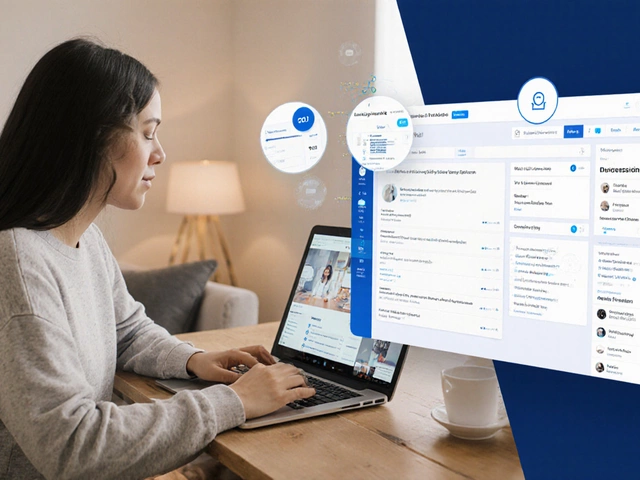If you've ever stared at your phone wondering why your English still sounds like a robot, you're not alone. So many people download popular language apps only to get stuck repeating "The cat drinks milk" while wishing they could just have a fun chat or nail that tricky pronunciation. The world of English speaking apps is exploding right now, and it's honestly a jungle out there. Some apps pump you full of words but leave you tongue-tied in real life. Others throw you into conversations so fast you feel like you just ran onto a movie set mid-line. So, is there that one magical app—or is the real answer more complicated (and interesting) than you think?
What Makes a Good English Speaking Practice App?
Before scrolling the App Store or getting sucked into another ad promising "native-like fluency in a week," let's get real about what actually matters. Speaking English is a mix of grammar, vocabulary, pronunciation, confidence, and—this often gets left out—the guts to keep talking even if you mess up. A great English speaking app doesn't just give you vocabulary flashcards; it sets up a fun, low-pressure space to talk, mess up, get feedback, and improve.
The best apps combine a few things: smart speech recognition (so your phone can catch those slightly-off th sounds), real conversation partners (bots and real humans), and practice with everyday English—not just textbook stuff. According to a 2024 report from App Annie, usage of live conversation and role play features in English apps has jumped 43% in the past two years. People crave real talk, not just quizzes.
Pronunciation help is a must. If you're practicing "v" and "w" in your bedroom, does it actually sound right? Only advanced AI or honest native speakers will tell you. That's why apps adding speech feedback—like Elsa Speak—are popular with users targeting accent improvement. But here's a reveal: apps that offer scheduled conversation exchanges (Lingbe, HelloTalk, or Tandem) have higher retention rates. People stick around longer when they get to chat for real, not just drill exercises alone.
Another interesting feature? Asynchronous voice replies. Not all learners can jump into live conversation, especially if schedules or nerves get in the way. Systems letting you record replies and get corrections at your own pace are a game changer for shy learners.
Top English Speaking Apps: Pros, Cons, and Real-User Vibes
The choices seem endless, with every app boasting “AI-powered learning” or “native tutors in seconds.” So, which apps actually deliver? Here’s a breakdown of the hype, the facts, and the subtle differences you can’t spot in just a 2-minute free trial.
- Duolingo: It’s the top name everyone knows. The catchy green bird is everywhere. But when it comes to speaking, it’s more about repeating phrases back than holding a real chat. Good for complete beginners but not if you want real conversation. It does score high for user streaks and engagement.
- Elsa Speak: This app is laser-focused on pronunciation. Elsa uses strong AI to listen and visually show how your pronunciation compares to native speakers, down to the single sound. It pushes you to record and retry until improvement. People prepping for interviews or customer-facing jobs rave about it. Downside: There’s not much back-and-forth conversation, it’s more like targeted speech coaching.
- HeyPal: It’s growing fast among teens and young adults. Think language exchange, but in a social-media style feed. You swipe, you share voice notes, you help others correct posts. It’s addictive and has a global vibe, but the chat format isn’t ideal for practicing long, structured answers, like in job interviews.
- Tandem: Pure language exchange. You find real people wanting to learn your language, and you help each other. You can chat by text, voice message, or video call. There’s a strong feeling of community, but reliability is hit and miss—sometimes your speaking partner is super into it, other times you’re ghosted after two messages.
- Preply: This one flips the script—here, you pay for one-on-one video lessons with real tutors. It costs more than most apps, but you get structure, homework, and answers right when you need them. People serious about professional growth or passing language exams spend the most time here.
- Speechling: Speechling gives feedback from real coaches who analyze the voice clips you send. You get corrections on sentences you record, and it’s tailored for accent reduction and fluency practice. No bots, just honest reviews on your skills. Downside? Lower “fun” factor, more for people who enjoy focused drills.
- HelloTalk: Similar to Tandem, but with more gamified elements and built-in translation tools. You can practice by sending voice notes or even jumping into calls if you want. The ability to tap any sentence and get an instant translation makes it less scary for beginners.
- italki: Like Preply, but with the widest network of certified native teachers and informal community tutors. Live lessons mean instant feedback and custom topics, plus you can filter tutors by accent, price, style, or availability.
- Babbel: Known for solid grammar and vocabulary, but its speaking exercises are quite basic. Useful as a supplement, but not as your main conversation tool.
- Busuu: Offers some live practice sessions, but the gold is in the peer-review feature. Record a phrase, send it to the community, get fixes. It’s like having free micro-tutors everywhere.
Let’s stack up some key data for 2025. Check this table summarizing features, target users, and pricing (as of June 2025):
| App | Live Conversation | Speech Feedback | Best For | Free Version | Approx. Monthly Price (USD) |
|---|---|---|---|---|---|
| Duolingo | No | Limited | Beginners | Yes | $0–$13 |
| Elsa Speak | No | Excellent | Pronunciation | Yes | $0–$12 |
| Tandem | Yes | User-based | Social Learners | Yes | $0–$10 |
| italki | Yes (Paid) | Tutor Feedback | Serious Learners | No | $10–$30 (per class) |
| Preply | Yes (Paid) | Tutor Feedback | Professional Use | No | $15–$35 (per class) |
| HelloTalk | Yes | User-based | All Levels | Yes | $0–$13 |
| Speechling | No | Real Coaches | Accent/Fluency | Yes | $0–$19 |
| Babbel | No | Basic AI | Grammar Lovers | No | $14 |
| Busuu | Some | User Feedback | Peer Learners | Yes | $0–$14 |

How to Make the Most out of English Conversation Apps
Scrolling app feeds won’t magically turn you into a confident speaker—you have to use these platforms smartly. Here’s a reality check: most people drop English learning apps after two weeks unless they see progress or have fun. The secret isn’t in finding the “perfect” app. It’s about hacking your routine so you get real practice instead of drifting off into endless scrolling or redoing the same old exercises.
First, schedule regular (even short) speaking sessions just like you would with gym time. Consistency beats marathon sessions that leave you burned out. A study by Cambridge English found that daily 10-minute speaking bursts are more effective than cramming all practice into the weekend.
Next, don’t just “play” with an app; set little goals. For example, today you might aim to introduce yourself, ask about someone’s job, or describe your favorite meal in detail. Apps like Tandem or HelloTalk make this simple—just drop a voice message with your goal for the day and see who bites.
If you’re shy or not ready for real-time video or audio chats, use apps that offer voice recording and asynchronous feedback. Elsa Speak and Speechling shine here. These platforms let you get used to hearing yourself and track exactly which sounds or words need work.
Don’t forget to use the feedback loop. When you make mistakes (and you will), jot them down. Keep a “Mistakes Diary” either in your phone or on old-fashioned paper. Notice any repeats? Focus there next time. Most successful learners aren’t perfect talkers—they’re the ones who get comfortable making mistakes, get tips, and fix them on the next try.
Here’s another underrated move: mimic real-life situations. Practicing with scripted dialogues is good, but try talking about your actual day, chat about the news, or describe the last movie you saw. If you can, pick a conversation buddy interested in similar things, so your motivation stays high.
Finally, mix and match. Stack a vocabulary-focused app like Duolingo with a pure conversation one like italki or HelloTalk. This combo covers both accuracy (words, grammar) and fluency (how smoothly you speak). Most advanced learners pull bits from two or three apps, steering clear of boredom and repetition.
Tips, Tricks, and Pitfalls for Staying on Track
Alright, so which pitfalls mess up most English learners on these apps? One, getting too focused on “perfect” pronunciation. Sure, a clear accent helps, but obsessing over every sound slows you down. Even native speakers bend the rules—listen to regional British or American accents for proof. It’s better to focus on being understood.
Another common trap: expecting instant results. No app, no matter how fancy, is magic. It usually takes three to six months of steady, active use to see real changes in your spoken English. That’s why community features—in forums, groups, or partner chats—act as your personal cheerleaders when motivation dips.
People also get stuck using only text chat, instead of recording and speaking. Text feels safer, but you won’t build confidence just typing. Push yourself to send at least one voice message or join one audio call per day. Apps like HelloTalk and Tandem have built-in encouragement icons to make this fun instead of scary.
Be careful about time zone mismatches, especially with international language exchange partners. If possible, use the native speaker filters or preferences to match people active when you are. That reduces gaps and dead conversations.
Lastly, watch out for overwhelm. With so many options, it’s tempting to jump between new apps each week. Pick two, stick with them a month, and evaluate your progress honestly. Most platforms now provide “activity” dashboards, so you can actually see days practiced, time spoken, and areas improved. Use that as your scoreboard, not just your gut feeling.
The bottom line? The best English conversation app isn’t just the one with the most advanced AI or biggest user base. It’s the one that fits your vibe—maybe you like quick 1-minute challenges, or deep video chats about world events, or structured lessons where you pay a bit extra for a pro tutor. The *real* winning move is steady, varied practice, not endless searching for the next big thing. Get speaking, make friends, laugh at the weird sentences you create, and your English will sound better before you even realize you’re improving.




